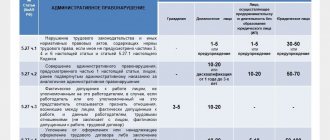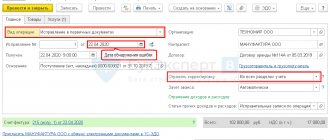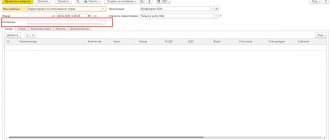Tax period codes
Tax period codes for declarations can consist of a wide variety of digital combinations: 01, 31, 34, 24, etc. They encrypt information about the tax period established by tax legislation for each tax.
IMPORTANT! A tax period is a calendar year or another period of time, after the end of which tax is calculated and paid (Clause 1, Article 55 of the Tax Code of the Russian Federation).
Next, using examples, we will decipher the period codes for individual taxes.
Taxable period
A tax period is understood as a certain time interval for which the tax base is determined. Moreover, for each type of tax, the legislation establishes its own time period, for example, a month, a quarter or a year. In addition, for certain taxes, tax periods are also divided into reporting periods, for each of which advance payments are calculated and paid. The reporting period for each tax is determined by the Tax Code of the Russian Federation and they are presented: quarter, half year and 9 months.
Important! In certain cases, a monthly form may also be used, for example, if a company is required to pay income tax on actual profits, then advances are calculated for a reporting period equal to a month.
VAT return tax period codes: 21, 22, 23, 24
The tax period in the VAT return is most often indicated by the numbers 21, 22, 23 and 24. They are entered in accordance with Appendix 3 to the order of the Federal Tax Service of Russia dated October 29, 2014 No. ММВ-7-3 / [email protected] , which is for tax periods 2019 -2020 applies as amended on November 20, 2019.
The numbers in the tax period code in the VAT return mean the following: the first digit of the code is a number that is always equal to 2, and the second digit varies depending on the quarter number. For example, 24 is the VAT return for the 4th quarter.
Similar codes are used in tax returns, the reporting periods for which are quarterly. In addition to VAT, such taxes, for example, include water (Article 333.11 of the Tax Code of the Russian Federation) or UTII (Article 346.30 of the Tax Code of the Russian Federation).
You will find a completed VAT return in ConsultantPlus. Try the system for free and proceed to the practical example and sample.
Tax and reporting periods for federal taxes
Value added tax (VAT) . The tax period is a quarter. The reporting period is a quarter (Article 163 of the Tax Code of the Russian Federation).
Excise taxes . The tax period is a month. The reporting period is a month (Article 192 of the Tax Code of the Russian Federation).
Personal income tax (NDFL) . The tax period is one year. The reporting period is a year (Article 216 of the Tax Code of the Russian Federation).
Corporate income tax . The tax period is one year. Reporting periods - the first quarter, half a year and nine months of the year or a month, two months, three months and so on until the end of the year, depending on how the advance tax payment is determined (Article 285 of the Tax Code of the Russian Federation).
Fees for the use of objects of the animal world and for the use of objects of aquatic biological resources . There is no tax period as such - the amount of fees is calculated and paid upon receipt of a production permit (Article 333.5 of the Tax Code of the Russian Federation).
Water tax . The tax period is a quarter. The reporting period is a quarter (Article 333.11 of the Tax Code of the Russian Federation).
Government duty . There is no tax period as such - the amount of the duty is calculated and paid upon application to perform legally significant actions (Article 333.18 of the Tax Code of the Russian Federation).
Tax on additional income from the production of hydrocarbons . The tax period is one year. Reporting periods are the first quarter, half a year and nine months of the year (Article 333.53 of the Tax Code of the Russian Federation).
Mineral extraction tax (MET) . The tax period is a month. The reporting period is a month (Article 341 of the Tax Code of the Russian Federation).
“Profitable” report with codes 21, 31, 33, 34
Reflecting the tax reporting period, code 21 in the income tax return is similar to the quarterly tax coding discussed in the previous section and means the report for the 1st quarter. The number 31 is entered in the semi-annual declaration. Code 33 denoting the tax period in the income tax return indicates that the information reflected in this document relates to the reporting period from January 1 to September 30 (for 9 months), and tax period 34 is entered in the annual “profitable” declaration.
The specified codes are not used by all taxpayers filing a “profitable” declaration. Firms that pay monthly advance payments on actually received profits use a different coding: 35, 36, 37, etc.
Such encryption of the tax period of the “profitable” declaration is provided for in Appendix 1 to the procedure for filling out the declaration, approved by Order of the Federal Tax Service dated September 23, 2019 No. ММВ-7-3 / [email protected] , applied from reporting for 2022. A similar encoding existed before.
You can see and download a practical example and a sample of filling out an income tax return in ConsultantPlus, having received free trial access to the system.
To learn about the deadlines for submitting a profit tax return, read the article “What are the deadlines for submitting an income tax return?” .
Tax period code in the declaration according to the simplified tax system
Important! Under the simplified taxation system (simplified taxation system), the tax period is understood as a calendar year, and the reporting period is understood as a quarter, half a year and 9 months. Unlike income tax, calculations for advance payments are not submitted to the tax office.
As with the taxes discussed above, standard codes are used for the simplified tax system, that is, code “34” is entered in the declaration for the simplified tax system for the year. In addition, some special tax period codes are also used:
| Special tax period code | What does it mean |
| 50 | Indicated upon liquidation or reorganization of a company |
| 95 | Last tax period under the old tax system |
| 96 | Applicable in the last period of work of an individual entrepreneur using the simplified tax system |
If a taxpayer loses the right to work under the simplified tax system during the year, then the tax period will be the period of time while the right to the simplified tax system was still available. For example, the company lost the right to use the simplified tax system in October, so it will have to file a declaration after the expiration of this right, and indicate 9 months as the reporting period (code “33”).
Tax period code in the payment slip: field 107
The tax period code is indicated not only in declarations, but also in payment orders for transferring tax payments to the budget. Field 107 is intended for this.
Find out how to fill out field 107 correctly in the material “Indicating the tax period in the payment order.”
Unlike the 2-digit codes indicating the tax period in declarations, the “payment” code for the tax period consists of 10 characters. Its composition:
- the first 2 characters indicate the frequency of tax payment in accordance with tax legislation (MS - month, CV - quarter, etc.);
- the next 2 characters are the number of the month (for monthly payments from 01 to 12), quarter (for quarterly payments from 01 to 04), half-year (for semi-annual payments 01 or 02);
- in 7–10 digits - indication of the year for which the tax is paid.
For example, in field 107, the tax period may look like this: “Qtr.03.2020” - this means payment of tax for the 3rd quarter of 2020.
In addition to the tax period code, payment orders for the payment of taxes also use other codes, for example the budget classification code KBK. To find out in which field of the payment order you need to indicate it, where to get information about the correct BCC and what the consequences of indicating it incorrectly, read the materials:
- “Deciphering the KBK in 2022 - 2022 - 18210102010011000110, etc.”;
- “Fill in field 104 in the payment order (nuances).”
Tax period code in the organization’s property tax return
When calculating property tax, the previous year is taken into account for the tax period (379 Tax Code of the Russian Federation). Reporting periods may not be established, in which case the calculation and payment of advance payments will not be required. However, this type of tax has some nuances. Companies that have branches, divisions or real estate in other regions are required to submit their own declaration for each facility.
The property tax of companies is regional, which means that payments go to the budget of the region in which the payment is made, and not to the state budget. Separate divisions of the company must pay this tax independently. Situations are also possible in which the parent company does not pay advance payments, and its divisions or branches located in other regions are required to pay advance payments 2-4 times a year.
Important! If a company has real estate in another region that does not belong to a separate division, then the parent company must draw up a separate declaration for it and send it to the tax region at the location of the property.
The tax period codes included in the declaration will be identical to the income tax declaration codes. For example, when submitting an annual declaration, code “34” is entered. Submission of reports for each month for this type of tax is not provided (
Results
The code reflecting the tax period is entered in declarations and payment orders for the transfer of tax payments. A 2-digit code is used for declarations, and a 10-digit code is used for payments. Both encodings allow you to identify the tax period for which a return is filed or tax is paid.
Both in tax returns and in payments, another code is used - OKTMO. Read about its reflection in the payment order in the article “OKTMO in the payment order (nuances)”.
Sources:
- Tax Code of the Russian Federation
- Order of the Federal Tax Service of Russia dated September 23, 2019 No. ММВ-7-3/ [email protected]
- Order of the Federal Tax Service of Russia dated October 29, 2014 No. ММВ-7-3/ [email protected]
You can find more complete information on the topic in ConsultantPlus. Free trial access to the system for 2 days.
Tax period code in the UTII declaration
When applying UTII (single tax on imputed income), the tax period is one quarter. In addition, in this case it will also be the reporting period. The deadline for submitting the UTII declaration to the tax office is until the 20th of the month following the reporting quarter, and payment is due until the 25th. The tax period codes in the UTII declaration are indicated as follows:
| Taxable period | Tax period code |
| 1st quarter | 21 |
| 2nd quarter | 22 |
| 3rd quarter | 23 |
| 4th quarter | 24 |
In addition, there are also special codes when filing a declaration in the event of liquidation or reorganization of a company: codes from 51 to 56 - for the first, second, third and fourth quarters, respectively. The number “5” in the code, which is in first place, indicates that this period is the last for the company’s activities. After this, the company is liquidated or reorganized into another company, which may apply a different taxation system.
Reporting periods for “profitable” declarations and deadlines for filing them
A thorough calculation of income tax is carried out at the end of the year, however, the tax code provides for advance payments:
- Quarterly;
- Monthly, the tax amount is calculated from the actual profit received.
Making advance payments entails the provision of periodic reporting, which is compiled with an accrual total:
- First quarter;
- Half year;
- Nine month;
- Year;
- Monthly (one month, two, three and so on).
When submitting an income tax report, a potential taxpayer is required to indicate the appropriate tax period code, the procedure for application of which is regulated by Order of the Federal Tax Service No. ММВ-7-3/600.
Note! The rules for choosing a reporting period for “net” profit tax depend on the amount of income received.
If the quarterly income of the enterprise does not reach the 15 million mark, then the reporting period will be a quarter. If this limit is exceeded, then the organization is obliged to switch to a “monthly” reporting scheme for this tax, and, accordingly, to a monthly form of payment of advance payments. Such a transition is carried out either from the beginning of the subsequent tax period or at the initiative of the taxpayer.
Regarding the deadlines for filing an income tax return, the taxpayer is required to submit this report form by the 28th day following the reporting period:
Reporting period – quarter:
- Until April 28 - for the first quarter;
- Until July 28 - for the first half of the year;
- Until October 28 - 9 months;
- Until March 28 - one year.
Reporting period – month:
- Until the 28th day of the month following the previous one.
Based on the results of the annual declaration, the taxpayer is also obliged to pay by March 28 of the following year, and the payment deadline is not postponed to another business day.
Profit reports
Earnings statements are classified differently than quarterly forms. For example, a profit declaration must be filled out with cumulative results from the beginning of the year.
The codes need to be set like this:
- First quarter – 21
- Tax period for the first half of the year – 31
- Tax period 9 months – 33
- Tax period code 34 – report for the full 12 months of the year
If a company submits profit reports every month, then a different codification is used. For example, the first month is designated using the code 35, the next - 36, and so on.
The basic rules for entering data into income tax reporting are established by Order of the Federal Tax Service of the Russian Federation No. ММВ-7-3/ [email protected]
Code 50 is used in the report for companies that are at the stage of reorganization or liquidation. In other words, it is applied to reflect the last tax period when a legal entity is reorganized.
Income tax return: period code
Appendix No. 1 to the Procedure for filling out the DNNP, approved by Order of the Federal Tax Service of the Russian Federation dated October 19, 2016 No. MMV-7-3/572, will help the user understand the codes that should be indicated when drawing up the declaration. It provides comprehensive information about all used ciphers and their meanings, and also establishes rules that should be followed when registering DNNP.
The period code allows the declarant to indicate the period of time for which the document is being generated, and the inspectors to quickly determine it. Please note that these codes vary depending on the status of the enterprise. For example, they are not identical for ordinary companies and consolidated groups of taxpayers (CGT), and also differ when submitting reports monthly or quarterly. Here are examples of valid ciphers:
| Period | For regular businesses | Cipher | For KGN | Cipher |
| - for 1 sq. | Reporting quarterly | 21 | Reporting quarterly | 13 |
| - for half a year | 31 | 14 | ||
| — 9 months | 33 | 15 | ||
| - year | 34 | 16 | ||
| - within 1 month | Reporting monthly | 35 | Reporting monthly | 57 |
| - within 2 months | 36 | 58 | ||
| - within 3 months | 37 | 59 | ||
| - within 4 months | 38 | 60 | ||
| - within 5 months | 39 | 61 | ||
| - within 6 months | 40 | 62 | ||
| - within 7 months | 41 | 63 | ||
| - within 8 months | 42 | 64 | ||
| - within 9 months | 43 | 65 | ||
| - within 10 months | 44 | 66 | ||
| — in 11 months | 45 | 67 | ||
| - in a year | 46 | 68 |
Thus, the codes for the declared periods, including the code for the annual income tax return, differ significantly for companies with different statuses and different reporting periods. For example, the largest taxpayer reporting quarterly will indicate the semi-annual declaration with code “14”, and an ordinary company will indicate code “31” in the income tax return.
In addition, there is a special code entered by liquidated or reorganized enterprises - “50”. It marks the company's last tax period.







